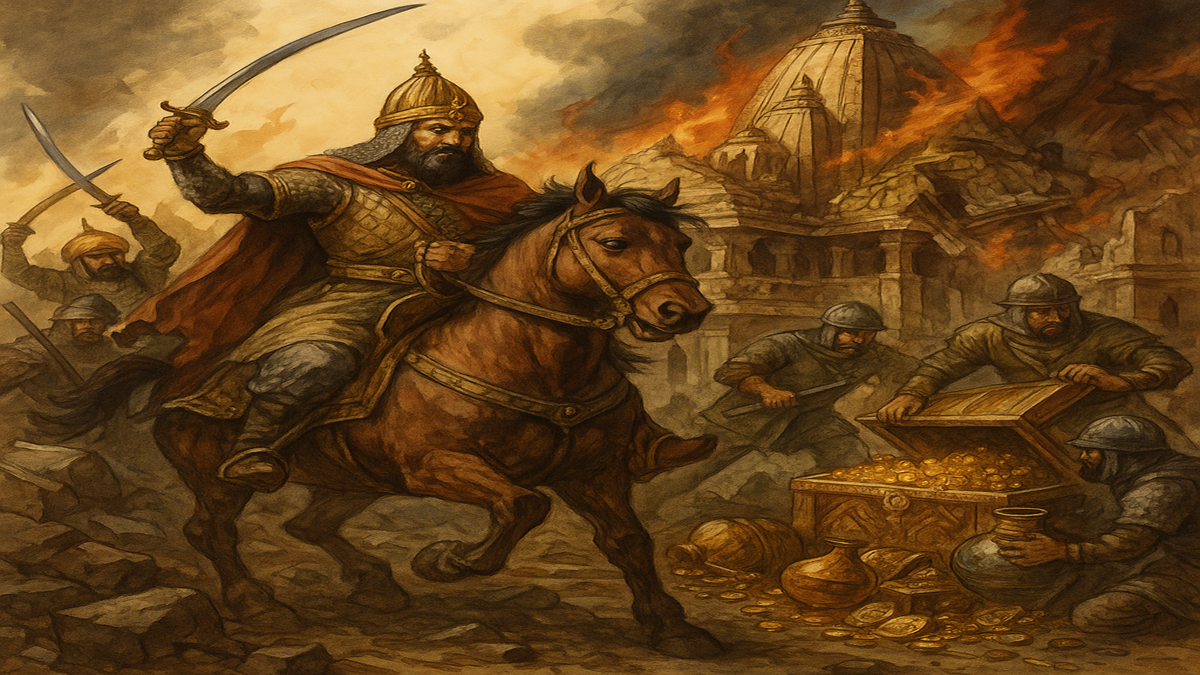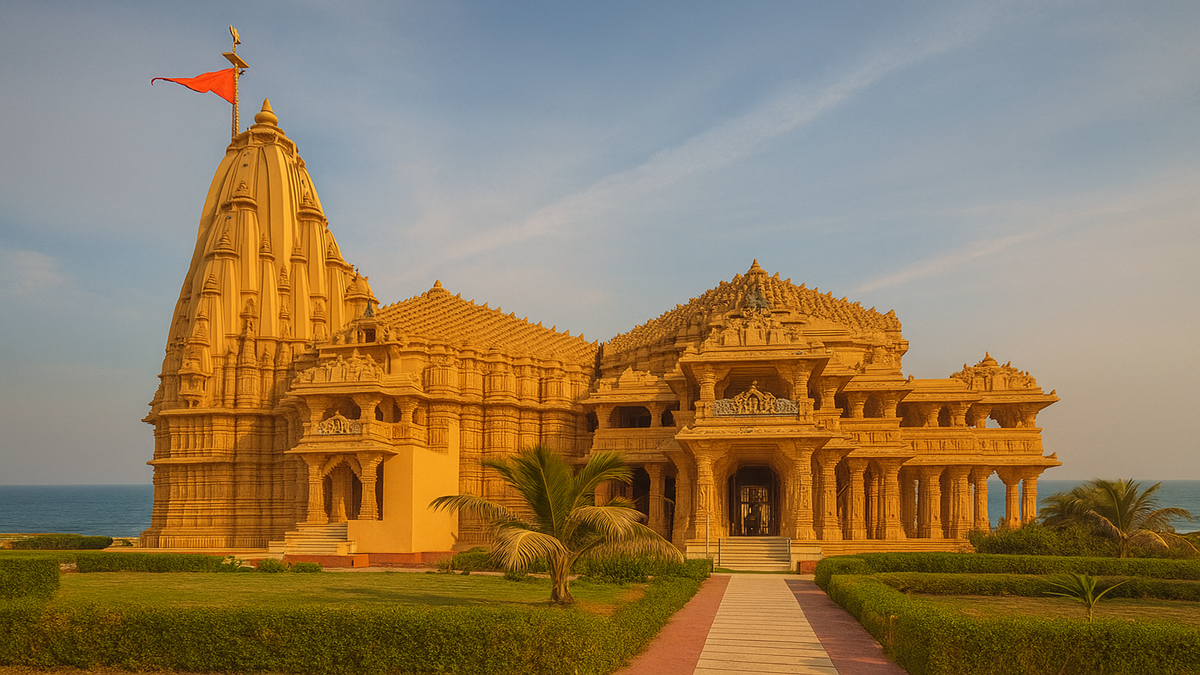Table of Contents
Contents
On the west coast of India, where the Arabian Sea meets the land with waves that whisper ancient tales, the iconic Somnath Temple of Gujarat is a shrine, but it’s also a living testament to unwavering faith and the fortitude of India’s legacy. As the first among twelve Jyotirlingas, the Somnath Temple Jyotirlinga is significant in Hindu tradition as a pillar of light representing Lord Shiva, its energy, history, and resilience.
But why is Somnath so famous? What about it is so beloved across the generations? Let’s uncover the layers of devotion, destruction, and rebirth to get to the history of Somnath Temple.
Where is Somnath Temple Located?
Located in Prabhas Patan, within the coastal city of Veraval, Gir Somnath district of Gujarat, the Somnath Temple is synonymous with mythology and nature’s beauty, where Kapila, Hiran, and the now-imaginary Saraswati converge at Triveni Sangam – a site said to be spiritually charged. Being situated on the Arabian Sea shores makes this temple even more mystical, with crashing waves as the backdrop to centuries-old rituals that continue.
Why is Somnath Temple famous?
The glory of the Somnath Temple lies in its profound religious significance, mythological origins, and enduring history. Somnath Temple is said to be the first Jyotirlinga, where Lord Shiva appeared as an eternal pillar of light, representing his infinite power. The name “Somnath” relates to the mythology of Chandra, the Moon God, who was released from a curse after performing penance at this site. His renewed radiance bestowed divine acknowledgment on this holy ground.
However, Somnath’s fame goes beyond its legends. The temple was one of the richest temples in India in the medieval age. Not only did it attract devotion and piety from its pilgrims, but it also attracted the attention of various invaders. After numerous attacks, after repeated demolitions from foreign rulers, the temple continued to be rebuilt after being destroyed with more and more grandeur. The demolition and rebuilding of Somnath has created a rounded representation of faith, but has also solidified it as a symbol of perseverance, pride in culture, and national identity.
Whether pilgrims seeking blessings or historians tracing the soul of India, the Somnath Temple in Gujarat is a place that has resonated through the ages and across faiths.
Somnath Temple Significance: More Than Just a Shrine
The Importance of Somnath Temple lies mainly in two reasons: its divine and eternal death. Somnath is said to be the first of the twelve jyotirlingas, where Lord Shiva manifested as a cosmic pillar of light. Somnath derives its name from here too; the name means ‘Lord of the Moon’ and refers to the story where Chandra, the Moon God, was cursed by his father-in-law, Daksha, and prayed to Lord Shiva here to restore his complete brightness.
This celestial connection gives the temple its holiness. Its fame is due to its stature as a guardian of cultural identity. The Somnath temple story is one of recurring destruction and daring rebirth; a sacred building that was destroyed and built again, every time with more devotion and greater faith. Now, it is not just a religious site anymore, but a symbol of spiritual resistance and national identity.
Somnath Temple History: Myths and Monuments
The Somnath Temple has both legend and history as its sources. As per the mythology, the first original Somnath Jyotirlinga Temple was built in gold by Chandra (the Moon God), the second time it was rebuilt from silver by Ravana, and then the third time the temple was rebuilt in sandalwood by Lord Krishna. Although these stories are mythological in content, what is clear is that altogether the temple occupies a space in Indian memory.
Historically, the first stone structure was built within the early centuries of the first millennium, between 650–700 CE, in the reign of the Maitraka kings of Vallabhi. After it was destroyed by the Arab governor of Sindh, Al-Junayd, in 725 AD, Nagabhata II of the Pratihara dynasty rebuilt and extended the temple in the 9th century (815 AD). By the 11th century, it had become one of the richest temples of India. Later, the Chaulukya king Mularaja and then Kumarapala in the 12th century reconceptualized the temple in a grand architectural fashion, with the dedications of its reconstructions in stone.

But the temple’s magnificence drew various attacks. For the next several centuries, the temple suffered six major attacks from foreign invaders, the most infamous being that of Mahmud of Ghazni in 1025 CE, who plundered the temple of its riches and smashed the sacred Somnath Jyotirlinga. Nonetheless, the spirit of Somnath could never be extinguished due to the desecrations. Following every assault, the temple was rebuilt, stone by stone, with hands driven only by faith.
However, the present temple, which was rebuilt after Independence between 1947 and 1951, under the leadership of Sardar Vallabhbhai Patel, has been erected — a magnificent structure in Chalukya style, open sea facing, defiant and divine.
Who Built Somnath Temple Across the Ages?
The construction of Somnath Temple is a layered story of divine myths and royal patronage. While deities like Chandra and Krishna are credited in legends, historical contributions came from many rulers:
- The Maitraka kingdom probably built the earliest temple structure in the 7th century.
- Nagabhata II of the Gurjara-Pratihara empire strengthened and rebuilt the temple in the 9th century.
- Chaulukya rulers Mularaja and Kumarapala constructed architectural splendor with intricate carvings and the majestic shikhara of the temple.
- After many invasions and destruction, Queen Ahilyabai Holkar built a modest shrine at the site in the 18th century (1783) to protect its sacredness. The temple she rebuilt is today known as the “Old Somnath” or “Ahilyabai Mandir” and is located near the main Somnath temple.
- In the 20th century, Sardar Vallabhbhai Patel, with strong support from K.M. Munshi and Dr. Rajendra Prasad, took the courageous step of rebuilding the temple after the independence of India.

The modern-day temple, constructed in the traditional Chalukya style, displays a grand shikhara (spire), detailed stone carvings, and a sacred proposal facing the endless Arabian Sea – illustrating constancy, spirituality, and eternal devotion.
Who Attacked and Looted the Somnath Temple?
The Somnath Temple’s history is incomplete without acknowledging the relentless invasions it endured:
- In 725 CE, the first recorded attack was led by al Junayd, the Arab governor of Sindh.
- In 1025 CE, Mahmud of Ghazni performed the most notorious raid. He plundered the temple’s vast treasure, smashed the Somnath Jyotirlinga, and left devastation that resonated down the ages.
- In 1299, the temple was once again pillaged by the generals of Alauddin Khilji, Ulugh Khan, and Afzal Khan.
- Subsequently, Zafar Khan, Mahmud Begada, and Aurangzeb all launched ruinous missions against it, with Aurangzeb commanding its last destruction in the 18th century.
Every attack was meant to shatter the spiritual spine of the region. But what came next was stronger—the unshakeable determination of the people and monarchs who persisted in rebuilding it. The Somnath temple was attacked and looted 17 times during its history, a reflection of its lasting importance and the challenges it faced throughout. But each rebuilding that occurred afterward was not merely a rebuilding in structure, but a statement of defiance and worship—an unrelenting declaration that religion cannot be destroyed by violence.
The Lords in Somnath: A Cosmic Connection
At the heart of the Somnath Temple, there is the Jyotirlinga of Lord Shiva, who is a symbol of immeasurable energy and cosmic light. According to ancient texts, such as the Skanda Purana and Shiva Purana speak of Somnath as the Adi Jyotirlinga, as it is the very first place where Shiva manifested as a pillar of light representing his eternal and unlimited formlessness.
In legends, there is mention of the original Somnath Jyotirlinga having such a strong magnetic force, that it is supposed to have floated in their sanctum, held aloft only by magnetic force—a concept that continues to fascinate historians and devotees. Although the original lingam was destroyed during several invasions, the present one, having been restored, continues as a sense of spiritual continuity, strength, and steadfastness.

However, Somnath’s sacredness is more than just related to the Jyotirlinga. The temple has mythological links with other very important lords in somnath—Chandra (the Moon God), whose first temple to Shiva is said to have been built here to rid himself of a curse; Lord Krishna, who is said to have stopped his earthly journey in this vicinity; and even Ravana adding mythic significance. The blend of the Shaiva, Vaishnava, and cosmic mythologies means that Somnath is more than a Shiva temple, and instead, embodies a very large religious tapestry woven over time.
Somnath Temple Trust and Present-Day Glory
The Somnath Temple is now administered by the Shree Somnath Temple Trust, which was a conception of Sardar Vallabhbhai Patel, and was formally established through the deep involvement of national leaders like K. M. Munshi and Dr. Rajendra Prasad. The trust not only administers the daily religious activities but also has a profound involvement in the conservation of cultural heritage, education, and the development of the local community. Through the years, it has also established museums, schools, dharamshalas, and other pilgrim amenities to make Somnath a social and spiritual landmark.
Today, the Somnath Temple in Gujarat is a stunning seven-storey structure, incorporating Chalukyan architecture, an architecture of ancient devotion. One of its iconic landmarks is the Baan-Stambh (Arrow Pillar), which reads in ancient Sanskrit that there is no landmass between Somnath and the South Pole—an eloquent statement of the temple’s unique position at the edge of the subcontinent.
The Akhand Jyoti (eternal flame) burns continuously inside the temple, signifying that no matter what, the spirit of Somnath will never go out. Every day, aartis and rituals are performed and offered to the deity without disruption – and regardless of the time, tide, or terror, they are performed. Whether they are devotees, spiritual seekers, historians, or simply curious, pilgrims arrive here from all over the world to observe the sacredness of a space where faith and history continue to thrive in unbroken harmony.
Somnath—A Temple That Refuses to Fall
The Importance of Somnath Temple transcends its stunning architecture or even religious significance. It speaks of a bigger story—of a faith that will not be broken, of a heritage that will not be destroyed, and of a civilization that gets up every time it is knocked down.
Whether you are attracted by the divine summons of the Somnath Temple Jyotirlinga, by the strength of its history, or by the spiritual calm that pervades its shores, Somnath is a one-of-a-kind experience. It is not a place—it is an epiphany.
Aided by the light of its ever-evolving flame, we don’t merely observe the past—we sense the beat of India’s sacred heart, still strong.
Who Attacked and Looted the Somnath Temple
The Somnath Temple was attacked and looted by Mahmud of Ghazni in 1025 AD.
Subscribe Our Youtube Channel: https://www.youtube.com/@BhartiSanskriti-BS







